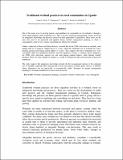Traditional wetland practices in rural communities in Uganda
Author
Date
2005Type
Articleviews
downloads
Metadata
Show full item recordxmlui.dri2xhtml.METS-1.0.item-citation
Traditional wetland practices in rural communities in Uganda Iyango L., Kiwazi F., Tindamanyire T., Kaganzi E., Busulwa H. and Mafabi P. Wetlands Inspection Division, Ministry of Water Lands and Environment, P. O. Box 9629, Kampala, Uganda
Abstract/
One of the major ways to develop policies and guidelines for sustainable use of wetlands is through a better understanding of their traditional uses. This is because traditional management systems are based on indigenous knowledge and practices passed on from generation to generation. These ideas are the ones that need to be promoted and applied during wetland management planning, as there is consequently a need to test a variety of potential use options for wetlands. Studies conducted in Busia and Rakai districts, revealed that in the 1940s cultivation in wetlands, sand mining and use of papyrus, ranked lowest (1 score), while the traditional use of wetlands for water, hunting, grazing and fishing ranked highest (5 scores). This suggests that these traditional uses were sustainable under low population densities and had regulatory systems, a situation which changed in the 1990s with cultivation, papyrus use and sand mining ranking highest, while hunting steadily declined. There are some changes in climate as a result of wetland use and conversion due to increased population. The study suggests that indigenous knowledge provides the best management options to the continued use of wetlands especially those that provide at least one known essential good, service, or attribute where alternatives are not practically or economically viable. Strategies for proper management planning for wetlands intended for use have been discussed.

